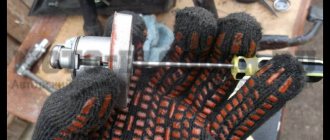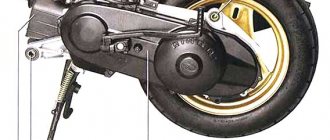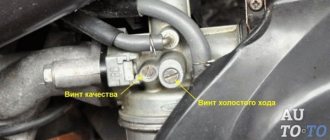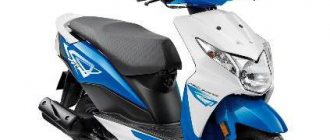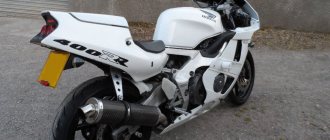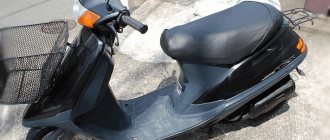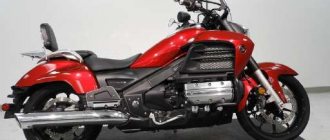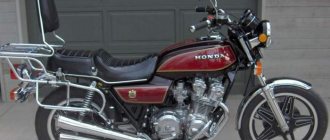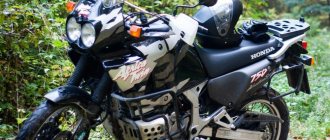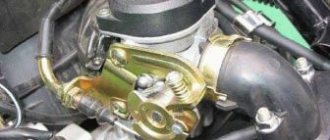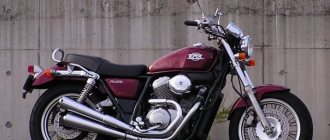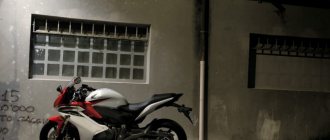Engine markings for Chinese scooters! Let's sort it out piece by piece.
Each motor of “rice” scooters has its own marking, which encodes the features of a particular unit. During scheduled scooter repairs (or unscheduled ones), many owners encounter some difficulties in finding spare parts, because they search for the main parts by the model name and not the engine marking. To do this, I recommend that you carefully examine the scooter’s engine, and after washing it of oil and dirt, find engraved numbers and Latin letters there. Most often, the location of these inscriptions is in two places:
- on the crankcase, underneath the cover, in the area of the front variator
- engraving in the gearbox area, also located on the engine crankcase.
Quite often I see how on forums and thematic groups on social networks, fans of the Chinese motorcycle industry argue that, for example, 152QMI and 157QMJ are different engines in principle. Let's figure out what all these numbers and letters mean. The first digit “ 1 ” ( 1 39QMB) in the marking will indicate that the engine has 1 cylinder. If you suddenly see the number “2” - go nuts, the scooter’s engine is two-cylinder. The letter “P” (1P39QMB) indicates that the cylinder is in a horizontal position. If the letter “P” is missing, then the cylinder on the scooter is not necessarily horizontal. So 139QMB and 1P39QMB, whatever one may say, are the same engines. The next two digits in the designation are “39”, “ 52 ”, etc. (1 52 QMI) denote the internal diameter of the cylinder liner, and accordingly the diameter of the piston and rings in the piston group. The first letter speaks about the scooter’s cooling system: “F” (139FMB, 1P39FMB) - air cooling of the motor occurs by free flow;
“Q” (139QMB, 152QMI, 157QMJ) - forced air cooling, there is a blower casing on the cylinder. If the letter is missing, the engine is most likely water-cooled (172MM - CH250). The second letter is the engine type: “M” (139QMA, 139FMA) - motorcycle engine. The third letter in the marking corresponds to the working volume of the cylinder-piston group of the scooter: “A” - up to 50 cubic meters (139QMA) - “honest” fifty dollars); “B” - up to 70 cubic meters (139QMB) - the most common, “almost honest” half-shock, which according to the rules should be labeled as 147QMB or even 150QMB;
"G" - up to 100 cubes; “H” - from 100 to 125 cubes (a rare variety of the GY6 family);
“I” - from 120 to 130 cubic meters (152OMI);
“J” - from 150 to 155 cubic meters (157QMJ);
“M” - up to 250 cc (172MM) - Chinese dropsy clone of Honda Spacy / Freeway with CH 250 engine.
Engines of the ARN family are also often found, with markings such as 153QMI, 157QMJ-H, 158QMI. Such engines are installed on Keeway and Stels scooters. They are often confused with the GY6 152QMI and 157QMJ family, both in the cylinder-piston group and in the cylinder head and all other parts of the engine. Although they are visually similar (152qmi-153qmi and 157qmj-158qmj), when purchasing spare parts it is worth checking these details with the seller. Concluding the “debriefing” on the dispute about 152QMI and 157QMJ, I would like to add on my own behalf that the engine data differs only in the cylinder displacement (52.4 mm and 57.4 mm). And such engines can also be called 1P52QM and 1P57QMJ.
Decoding the engine markings of Chinese mopeds and scooters
All Chinese-made engines have two names: one used domestically between different factories, the second for the whole world. Let's see what the letters on the engine mean, what the manufacturer writes and what is included in the technical documentation.
The first two or three letters are the abbreviation of the manufacturer. If there are no letters, then the engine was made to order from a neighboring plant, and this information is not very important, and the engine will be installed on a model with a different brand. There are cases when small assembly lines are “embarrassed” to advertise their name, and have not yet put these letters on the motor.
- the number “1” means that the engine has one cylinder, if the engine has
- the number “2″ means the engine is two-cylinder.
- letter “P” - the cylinder in the engine is located horizontally; if there is no letter, then the cylinder has a position other than horizontal.
- numbers “39″ – internal diameter of the cylinder
- the letter “F” means the engine is air-cooled, if the letter “Q” is written it means forced air cooling, if the letter is missing it means water cooling
- the letter “M” is a motorcycle engine (i.e., installation is suitable for mopeds, scooters, and motorcycles)
The third letter, after the digital designation of the cylinder diameter, means the volume of the cylinder:
- A- up to 50cc cm3;
- B – up to 70cc cm3;
- G – up to 100cc cm3;
- N – from 100cc to 125cc cm3;
- I – 120cc – 125cc cm3;
- J – 150cc cm3;
- L – up to 200cc cm3;
- M – up to 250cc cm3.
But, these designations are valid only for the engine stated in the technical documentation of the manufacturer. In fact, the plant can release a modification of the engine - in a forced version or in a deforced version. Unfortunately for some, and fortunately for others, it is impossible to determine the REAL cylinder volume of a particular device by the name of the engine.
Eight digits after the engine name: the first two are the year of manufacture, the remaining six are the engine serial number.
Where to find the frame and engine number on a scooter
and the Suzuki frame number is also located there . The fin is the lowest part of the scooter frame. The location of the code differs in different Suzuki scooter models.
engine model and can be seen at the top of the rear of the variator on the located platform.
Some information can be read on a paper or metal sticker with a number by opening the trunk of the scooter.
If you cannot find the frame or engine number on your scooter, write in the comments - we will try to help you. Good luck!
Source
| CA11A | Ran | CF50 | CA11A-100001- | — | 1983 | 4 l. With. |
| CA12A | Chance | CA50 | CA12A-10- | — | 1983 | 4 l. With. |
| CA13A | Bara | CY50 | CA13A-100- | — | 1983 | 3.8 l. With. since '84 4 l. With. |
| CA14A | Gemma Quest | CS50 | CA14A-100- | — | 1986 | 6.5 l. With. |
| CA14B | Shoot | CP50C | CA14B-100001- | — | 1984 | 6.5 l. With. since 1985 Disc brake |
| CA15A | Love III | CX50D | CA15A-100001- | — | 1984 | 6.0 l. With. |
| CA17A | Ran | CF50 | CA17A-10- | — | 1988 | 4.2 l. With. |
| CA18A | Carna | CI50DG | CA18A-100001- | — | 1985 | 6.5 l. With. |
| CI50DGH | CA18A-204765- | 1987 | ||||
| CA19A | Hi | CH50S | CA19A-100001- | — | 1986 | 6.5 l. With. |
| CH50SJ | CA19A-235167- | 1988 | ||||
| CA19B | Hi-R | CH50RH | CA19B-100001- | — | 1987 | 6.5 l. With. |
| CA1AA | Gemma Quest | CS50DC-2 | CA1AA- | K2F27 | — | 6.5 l. With. |
| CA1BA | Mode GT | CR50DC | CA1BA-100001- | — | 1987 | 6.5 l. With. |
| CA1CA | AddressTune | AD50T | CA1CA-100001- | — | 1988 | 7.0 l. With. Disc brake |
| AD50TK | CA1CA-124855- | 1989 | ||||
| AD50TL | CA1CA-152645- | 1990 | ||||
| AD50TM | CA1CA-160799- | 1990 | ||||
| CA1CB | Address | AD50 | CA1CB-100001- | — | 1987 | 6.5 l. With. |
| AD50K | CA1CB-170387- | 1989 | ||||
| AD50L | CA1CB-203272- | 1990 | ||||
| CA1CC | Address way | AD50W | CA1CC-100001- | — | 1988 | 6.5 l. With. |
| CA1DA | Hi-UP | AE50 | CA1DA-100001 — | — | 1988 | 6.5 l. With. |
| AE50L | CA1DA-124210- | 1989 | ||||
| AE50N | CA1DA-160874- | 1992 | ||||
| CA1DB | Hi-UPR | AE50R | CA1DB-100001- | — | 1989 | 7.0 l. With. Disc brake |
| AE50RL | CA1DB-132088- | 1990 | ||||
| CA1EA | Sepia | AF50 | CA1EA-100040 | — | 1989 | 6.8 l. With. |
| AF50L | CA1EA-171966- | 1990 | ||||
| AF50M | CA1EA-192366- | 1990 | ||||
| AF50MM | CA1EA-227226- | 1991 | ||||
| CA1EB | Sepia ZZ | AF50ZZL | CA1EB-100032- | — | 1990 | 7.0 l. With. Disc brake |
| AF50ZZZ | CA1EB-147409- | 1991 | ||||
| AF50ZZM | CA1EB-219148- | 1991 | ||||
| AF50ZZN | CA1EB-232523- | 1992 | ||||
| CA1EC | Sepia ZZ | AF50ZZM | CA1EC-100001- | — | 1991 | 7.0 l. With. Disc brake |
| CA1EC | AF50ZZS | CA1EC-106446- | 1995 | |||
| CA1FA | Address V50 | AG50M | CA1FA-100037- | — | 1990 | 6.8 l. With. |
| AG50N | CA1FA-126207- | 1992 | ||||
| CA1FB | Address V50 tune | AG50TM | CA1FB-100027- | — | 1991 | 7.0 l. With. Disc brake |
| AG50TN | CA1FB-121699- | 1992 | ||||
| Address V50 | AG50T | CA1FB-129179- | 1995 | |||
| CA1HA | Sepia | AJ50P | CA1HA-100001- | — | 1993 | 6.8 l. With. |
| AJ50R | CA1HA-116509- | 1994 | ||||
| AJ50S | CA1HA-129644- | 1995 | ||||
| CA1HB | Sepia RS | AJ50SP | CA1HB-100001- | — | 1993 | 6.8 l. With. Disc brake |
| AJ50SR | CA1HB-106802- | 1994 | ||||
| AJ50SS | CA1HB-109264- | 1995 | ||||
| CA1HC | Sepia ZZ | AJ50ZZP | CA1HC-100001- | — | 1993 | 7.2 l. With. Disc brake |
| AJ50ZZR | CA1HC-142259- | 1994 | ||||
| AJ50ZZS | CA1HC-166416- | 1995 | ||||
| AJ50ZZT | CA1HC-176588- | 1996 | ||||
| AJ50ZZW | CA1HC-183715- | 1998 | ||||
| CA1JA | AP50 | AP50RF | — | — | — | 2N: not for Japan |
| CA1KA | Let's | AS50T | CA1KA-100001- | — | 1996 | 6.8 l. With. |
| AS50V | CA1KA-241778- | 1997 | ||||
| AS50W | CA1KA-308837- | 1998 | 6.3 l. With. | |||
| Let's 2 | AZ50T | CA1KA-131220- | 1996 | 6.8 l. With. | ||
| AZ50W | CA1KA-312667- | 1998 | 6.3 l. With. | |||
| AZ50UW | CA1KA-320427- | 1998 | ||||
| AZ50DW | CA1KA-322827- | 1998 | ||||
| Let's 2-L | AZ50LV | CA1KA-218619- | 1997 | 6.8 l. With. Low landing | ||
| AZ50LW | CA1KA-309557- | 1998 | 6.3 l. With. Low landing | |||
| CA1KB | Let's 2-S | AZ50SV | CA1KB-100001- | — | 1996 | 6.8 l. With. Disc brake |
| AZ50SW | CA1KB-106536- | 1997 | 6.3 l. With. Disc brake | |||
| CA1LA | Street magic | TR50V | CA1LA-100001- | A153 | 1997 | 7.2 l. With. Disc brake 12″ discs |
| CA1LB | Street magic S | TR50SV | CA1LB-100001- | A153 | 1997 | 7.2 l. With. Disc brake 12″ discs |
| Street magic -II | TR50SDV | CA1LB-111571- | 1998 | |||
| CA1MA | Verde | UR50W | CA1MA-100001 — | A148 | 1998 | 6.3 l. With. |
| CA1NA | Address | UG50W | CA1NA-100047- | — | 1998 | 6.3 l. With. Disc brake 12″ discs |
| CA1PA | Let's 2 | AZ50LX | CA1PA-125423- | A196 | 1999 | 6.1 l. With. |
| Let's 2-L | AZ50X | CA1PA-122783- | 1999 | 6.1 l. With. Combined brakes | ||
| CA1PB | ZZ | AZ50R | CA1PB-10- | A155 | 2000 | 7.2 l. With. Disc brake 12″ discs |
| CA41A | Let's 4 | UZ50FK | — | A404 | 2004 | 5 . 0 l. With. (Four-stroke) Electronic injector Manufactured in China |
| CA41A | Let's 4 Pallet | UZ50 GK | — | A404 | 2005 | 5 . 0 l. With. (Four-stroke) Electronic injector |
| CA4 2A | Address V50G | — | — | A404 | 2005 | 5 . 2 l. With. (Four-stroke) Electronic injector |
| FA14B | Mollet | FE50 | FA14B-100001 — | — | 19 86 | 6.1 l. With. Front disc 12″ |
guarblog.ru
- - Screwdriver Set;
- - camera;
- — computer with Internet access;
- - cotton gloves.
Carefully read the documents that come with the scooter. In them you will definitely find the exact model and modification of this two-wheeled vehicle.
There are quite a large number of scooters that have a similar appearance, but different filling. That is, different manufacturers and models have identical cases. In this case, determine the exact model by the markings on individual spare parts.
Remove the saddle and look for a yellow or white plate under it. It indicates the model with modification, as well as the manufacturer and technical specifications. If the sign is dirty, it should be cleaned using a semi-stiff brush and some cleaning solution. At the same time, be very careful not to tear off the paint that contains the data on the plate.
How to determine the year of manufacture of Honda scooters
How to determine the year of manufacture of Honda scooters
Honda scooters are the most popular fifty-fifty scooters in the world. Since 1979, this company has produced a huge number of scooters, many of which also travel on our roads. Many of us have wondered how to find out the year of manufacture of a scooter. how old is he and what are his main characteristics. Without certain data, it is quite difficult to determine the year of manufacture, and basically, the owner of such equipment from Japan has no idea how old the scooter is. Sellers very often write the year of manufacture of the scooter at their discretion, but you should not believe it. My Honda Lead AF-20 scooter, for example, was listed on the coupon as 1996. Knowing that they were produced before 1998, one could believe this, and the condition and appearance were excellent. But I knew how to determine the year of manufacture of a Japanese scooter, I opened the table and found out that the seller was lying after all. The scooter offered to me was from 1988, however, I bought it and am completely satisfied.
Now you can find out the year of manufacture of your scooter using the table that I have given below. An important point in this table is the frame number. To begin, write down the frame number of your scooter, then check it against the one provided in the table.
Determine the model, frame number, and hence the year of manufacture. This is the main point, and the traffic police use exactly the same table to determine what year of manufacture a scooter previously brought from Japan is.
You will also find the type designation, code name used by the manufacturer, engine type, scooter classification and general notes. The notes indicate the basic data that most clearly distinguishes a particular scooter from the mass of others in the company.
If you have any questions about the table, or you cannot determine the year of manufacture of the scooter yourself, write your question in the comment field, or create a topic on the forum. In any case, you will always receive a comprehensive answer.
Scooter Honda Spacy 125
Honda CB400 Super four version S
note2auto.ru
Decoding the engine number of a Chinese scooter
Let's look at the decoding of the engine number in more detail. As a rule, the engine number begins with an abbreviation of letters that tell about the plant where it was manufactured.
- RFB - Kymco
- RF4 - Chyong Horng Enterprise Co., LTD.
- LZS – Chongqing Zongshen Group
- LSR - Chongquing Hi-Bird Motorcycle Industry Co., LTD.
- LLC - Chongqing Kinlon S&T Group Co., Ltd.
- LL8 – Jiangsu Linhai Power Machinery Group – Linhai – Model Year 2006 or newer
- LHJ - Chongqing Astronautical Bashan Motorcycle Manufacture Co., LTD.
- LCE - Chunfeng Holding Group Co., LTD. – CFMOTO – Model Year 2003 and newer
- LB2 - Geely
- LAW – Power Sports Factory – Agent For – Qianjiang – Model Year 2003 and Newer
- LAN - Changzhou Yamasaki Motorcycle Co., LTD.
- LAE - China Qingqi Group, Inc.
- RFG - Sanyang Industry Co. LTD.
- LAA - Jialing
- L5X - Cixi Konced Motorcycle Co., LTD.
- L4Y – Qingqi Group Ningbo Rhon
- 5RY - Roketa
- RFB - STR Motorsports, Inc. dba Kymco USA
- LYD - Taizhou City Kaitong Motorcycle
- LJ4 - Shanghai Jmstar Motorcycle Co.
- LFG - Taizhou Chuanl Motorcycle Manufacturing Co., LTD.
- L8Y - Shanghai Shenke Motorcycle Co., LTD
- L5Y - Taizhou Zhongneng Import and Export Co., LTD.
- LFE - Wuxi Futong Motorcycles Co LTD
- LFF - Zhejiang Taizhou Wangye Power Co., LTD.
- L8X - Zhejiang Summit Huawin Motorcycle Co., LTD.
- L4S - Zhejiang Xingyue Vehicle Co., LTD.
- L1E - Zhejiang Lingyun Motorcycle Co., LTD.
It is noteworthy that the absence of an abbreviation may indicate the clandestine origin of the engine. The same thing happens if the scooter manufacturer ordered an engine from a “non-name” company.
This is followed by the number 1 or 2. This is an indicator of the number of cylinders. Usually cylinder 1, but for some reason this is always indicated. To make it easier to perceive information about the engine number, let’s take an arbitrary number as an example:
The first two letters LAA are visible, now we know what kind of scooter manufacturer
.
Next comes the number 1, this is the number of cylinders
.
The next letter P will tell you about the location of the engine
. It can be horizontal or vertical. The horizontal model contains the letters P in the number; the vertical engine does not have this letter.
The next number is 39. This is the diameter of the cylinder
. In this case, it says that the engine is fifty dollars, but often the manufacturer lies by installing a larger cylinder, thereby increasing the volume. Although he sells the scooter for fifty dollars and is not even shy. This step is forced, because the four-stroke Chinese fifty-kopeck car doesn’t want to go at all. It is much easier to increase engine capacity than to play tricks with other elements.
Engine markings of Chinese scooters
Chinese scooter engines can be two-stroke or four-stroke. All of them are produced directly in China by the scooter manufacturer or on order from a third-party company. Usually, no one is involved in the development of something new, since it is expensive, time-consuming and requires noble minds, of which there are not very many in this country.
Hence, all production lines are Japanese originals or slightly modified conveyors. Simply put, the engine that is on your Chinese scooter was on a Japanese Yamaha, Honda or Suzuki 15-20 years ago.
It is interesting that four-stroke engines better than two-stroke engines, hence their quality is somewhat higher. This means that a Chinese-made chotiritactic will be more reliable than two-stroke ones. There are also analogues of European models from the 80s and 90s, but there are very few of them.
Each engine of a Chinese scooter has markings that can tell a lot. A set of letters and numbers will tell you about the manufacturer's plant, the number of cylinders, cylinder location, piston diameter, combustion chamber volume and much more.
Honda Dio and other scooters
The first thing you need to know about Honda Dio is that this line of scooters is designed specifically for riding on asphalt roads. When purchasing a scooter for walking on dirt roads, you need to take into account that every season you will have to change the front and rear shock absorbers, which is generally not a problem, since they are always available for free sale.
In addition to the excellent ability to maneuver in city traffic jams, Honda Dio models have a number of invaluable advantages - excellent muffler protection, engine reliability (the scooter can “run” on any gasoline, even 76, although it is better not to save money and fill it with normal - 95 -th) and its “liveliness”, which is embodied in excellent acceleration dynamics. On Dio models you can easily accelerate to 70-80 kilometers per hour. Honda Dio is sold with both disc and drum brakes. The former are more effective, but also wear out noticeably faster.
Starting from the 34th model, scooters received a combined braking system: when using the front brake, the rear brake is automatically activated. This ensures driving safety.
Honda Dio models are ideal for tuning - if desired, you can accelerate the scooter to 90-100 kilometers per hour. However, it should be remembered that at such speeds the scooter is still in a “critical” state and overheats. Therefore, if you want to freely drive on the highways, it is better to choose other models for this.
Honda Dio is a scooter that is designed for one person. You can, of course, sit on it together, but comfort in this case is by no means guaranteed. However, the small size of the scooter also has its advantages - light weight and nimbleness.
